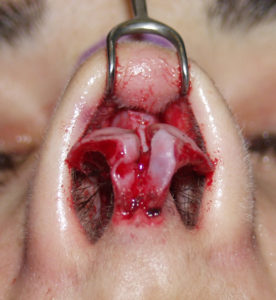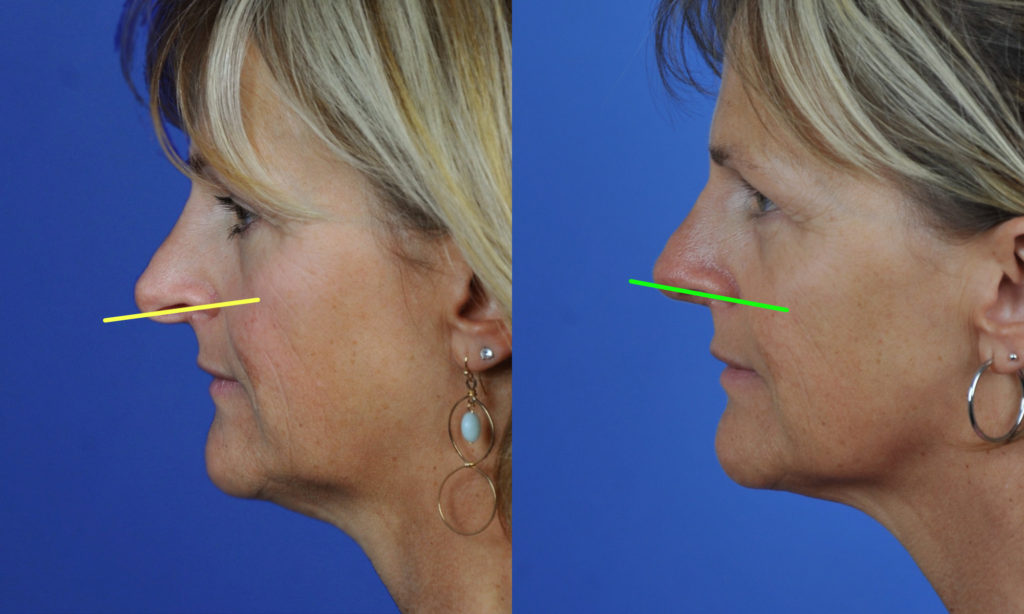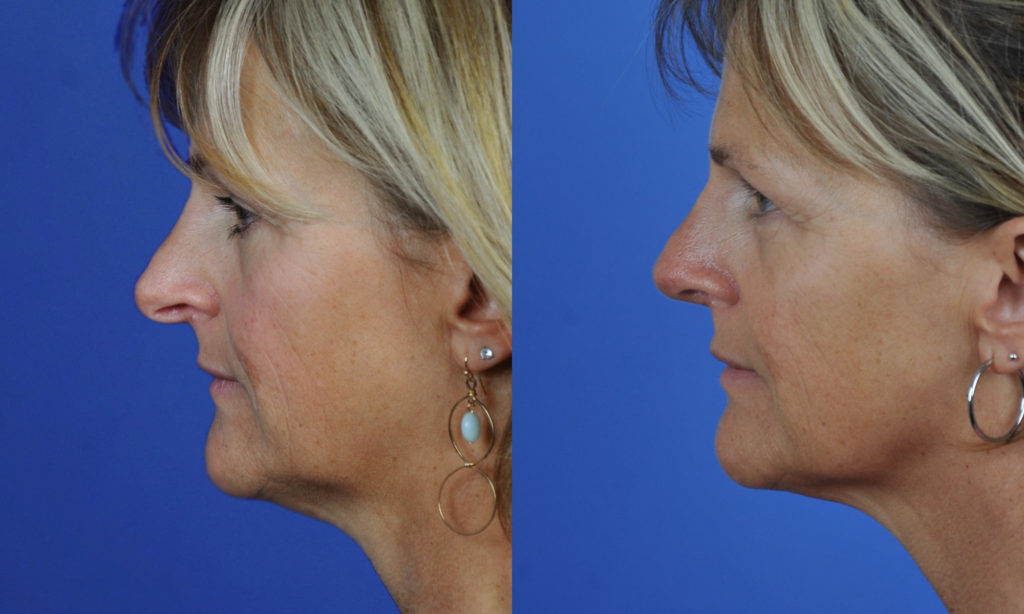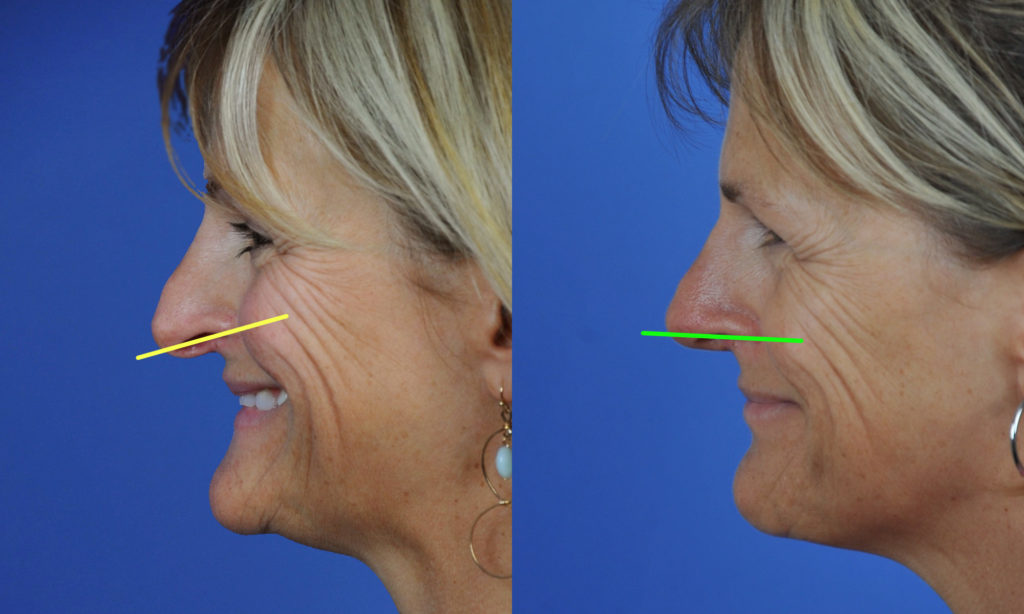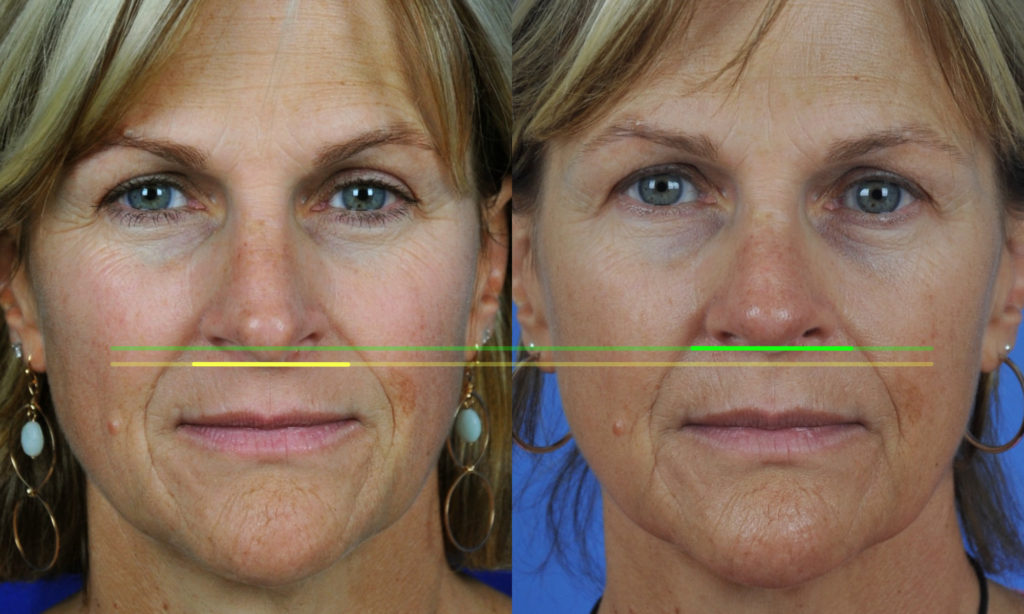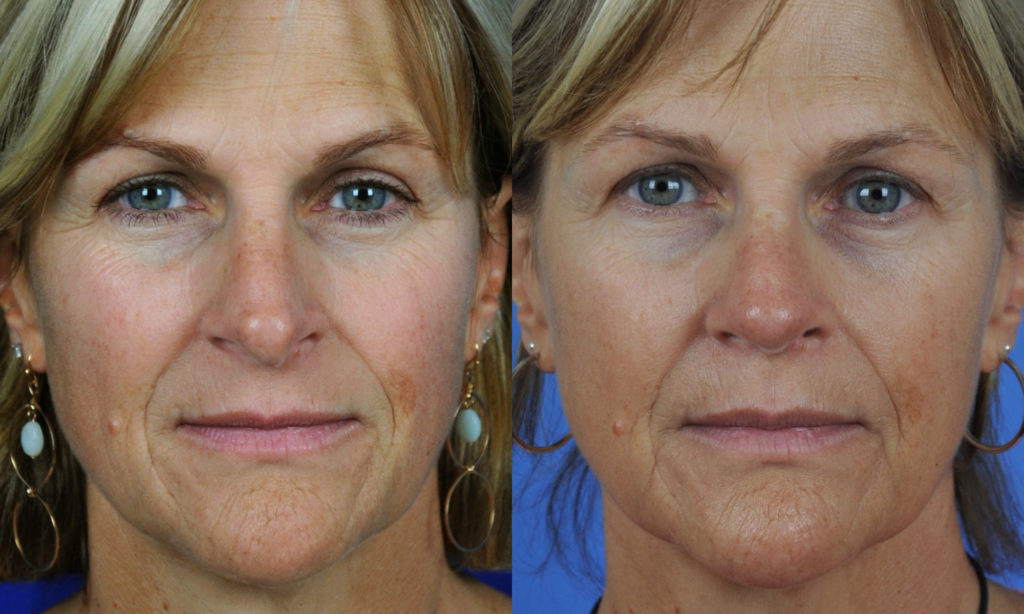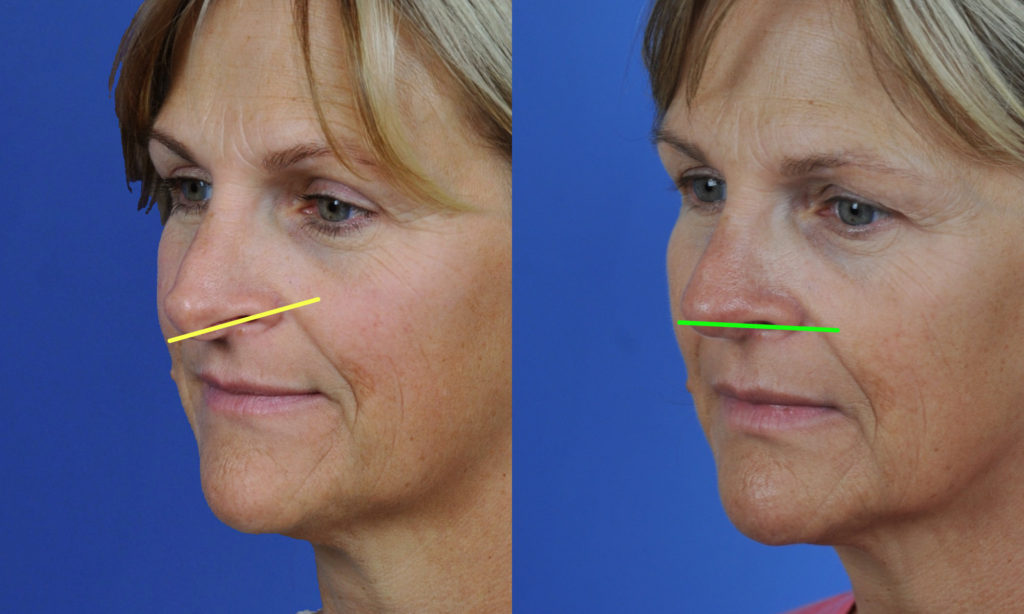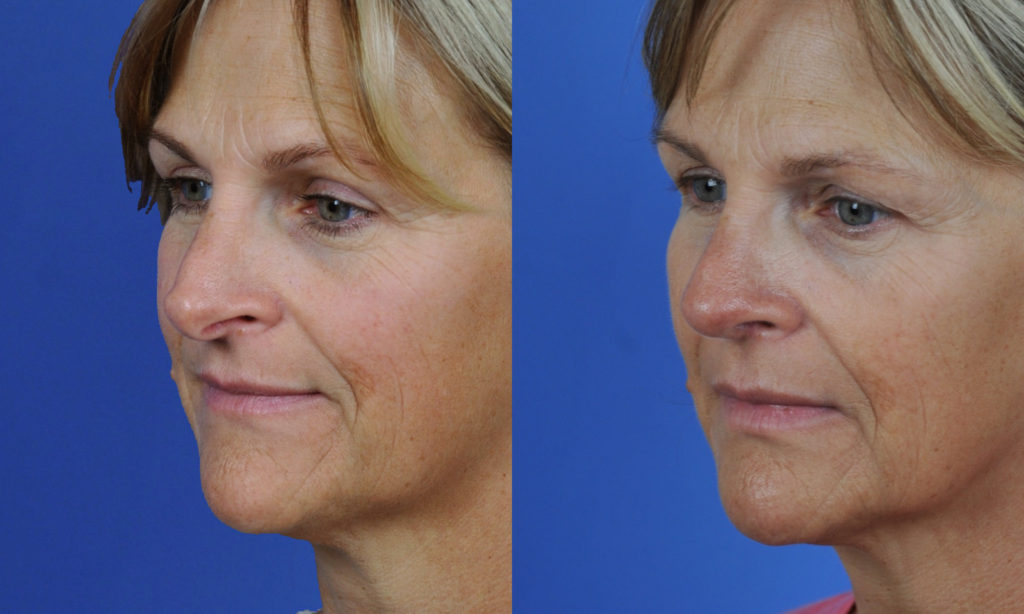Correcting a droopy nasal tip is one of the most common maneuvers I perform in terms of cosmetic rhinoplasty. We have previously touched on this topic in another of our rhinoplasty tutorial discussions. But additional case examples, like this one here, help to further highlight this type of cosmetic rhinoplasty surgery.
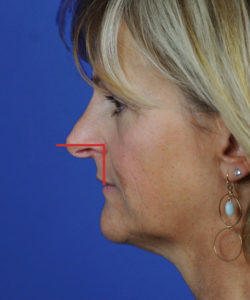 This patient from San Diego desired to have her nose reshaped to primarily address the droopy nasal tip. This is also referred to as a ptotic nasal tip – where the ‘p’ is silent and it pronounced ‘toe-sis’. If you look at her pre-rhinoplasty photo, you can see subjectively how her nasal tip region dominates the appearance of her nose – and mid face region to a great degree. If you measured her nasolabial angle (the angle created by the axis along the bottom of the nose crossing the axis of the upper lip),
This patient from San Diego desired to have her nose reshaped to primarily address the droopy nasal tip. This is also referred to as a ptotic nasal tip – where the ‘p’ is silent and it pronounced ‘toe-sis’. If you look at her pre-rhinoplasty photo, you can see subjectively how her nasal tip region dominates the appearance of her nose – and mid face region to a great degree. If you measured her nasolabial angle (the angle created by the axis along the bottom of the nose crossing the axis of the upper lip), 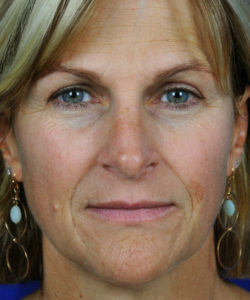 you would see that it is much less than the ideal female angle of 95-105 degrees. In fact, the red lines here represent a 90 degree angulation and you can readily see how her nasal tip is even less than this angulation. So, by definition, she has a droopy, ptotic nasal tip that would likely benefit from cosmetic rhinoplasty surgery to help lift it up just a bit. If you look at her frontal view prior to rhinoplasty surgery, you can see her nasal tip is not only droopy, or heavy-looking, but also slightly boxy in appearance. In the process of lifting the ptotic nasal tip, we discussed making some minor changes to the actual shape of her tip to create a more feminine overall look.
you would see that it is much less than the ideal female angle of 95-105 degrees. In fact, the red lines here represent a 90 degree angulation and you can readily see how her nasal tip is even less than this angulation. So, by definition, she has a droopy, ptotic nasal tip that would likely benefit from cosmetic rhinoplasty surgery to help lift it up just a bit. If you look at her frontal view prior to rhinoplasty surgery, you can see her nasal tip is not only droopy, or heavy-looking, but also slightly boxy in appearance. In the process of lifting the ptotic nasal tip, we discussed making some minor changes to the actual shape of her tip to create a more feminine overall look.
Plunging Nasal Tip
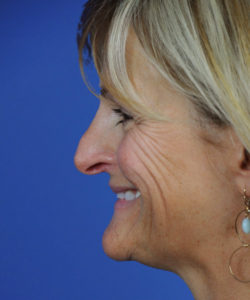 It is worth mentioning that some people would refer to this type of nose as having a ‘plunging’ tip. A plunging nasal tip means that the tip of the nose appears to droop down even more when the patient smiles. This can be seen in the adjacent photo of this same patient when she smiles. Compared to her resting profile photo above, you can see how the tip of the nose appears to plunge even lower down upon smiling. Although it certainly looks like the tip of the nose drops down with smiling, research has actually shown that the tip of the nose plunges very little with animation. It is thought that this illusion is more likely to result from movement of surrounding facial muscles – like those in the upper lip region. Regardless of the explanation, the appearance of this plunging nasal tip is still bothersome to many patients and needs to be addressed at the time of rhinoplasty surgery.
It is worth mentioning that some people would refer to this type of nose as having a ‘plunging’ tip. A plunging nasal tip means that the tip of the nose appears to droop down even more when the patient smiles. This can be seen in the adjacent photo of this same patient when she smiles. Compared to her resting profile photo above, you can see how the tip of the nose appears to plunge even lower down upon smiling. Although it certainly looks like the tip of the nose drops down with smiling, research has actually shown that the tip of the nose plunges very little with animation. It is thought that this illusion is more likely to result from movement of surrounding facial muscles – like those in the upper lip region. Regardless of the explanation, the appearance of this plunging nasal tip is still bothersome to many patients and needs to be addressed at the time of rhinoplasty surgery.
Open Rhinoplasty Approach
In order to accomplish these type of planned changes, I recommended we perform an open rhinoplasty approach. As opposed to a closed rhinoplasty approach, the open allows for much better visualization of the actual cartilage framework that forms the tip shape. Although there are some great rhinoplasty surgeons who prefer the closed approach, a majority of cosmetic nose specialists would likely use an open approach in this particular case. The adjacent photo demonstrates the type of visualization that can be achieved with a standard open rhinoplasty approach – showing the paired lower lateral cartilages that comprise a majority of the nasal tip.
In this particular case, I ended up disassembling the entire tip first. I then repositioned the lower lateral cartilages and reattached them to the caudal septum in a better location. In the process of doing this, as noted earlier, I also narrowed her tip – but just slightly in order to preserve her overall look.
Droopy Nose Tip Repair – Side
The results of this patient’s surgery are shown here. As you can see, the angulation of her nose (and the drooping tip) have been improved significantly following rhinoplasty. In the photo below, you can readily see how the angle of her nasal tip (yellow line) was primarily in a downward direction prior to rhinoplasty. Following cosmetic reshaping of the nose, her nasal tip is now closer to a 95 degree angulation, which is within the range of being ideal.
Droopy Nose Tip Repair – Smiling
When you look at her smiling lateral view, the improvement is arguably more dramatic. That is because, as noted previously, when one smiles, there is an illusion that the nasal tip drops down more. Regardless whether or not this is real, the visual appearance is still there. Following her cosmetic rhinoplasty, including lifting of the nasal tip, there is a much more acceptable positioning seen. Even with a wide grin, her nasal tip does not appear droopy at all.
Droopy Nose Tip Repair – Front
From the frontal view, you can also appreciate how the droopy nasal tip has been now lifted so that it appears less heavy. If you look more closely at her columella, you can really appreciate how this plunges downward much less than it used to. The green line in the diagram photo represents where the bottom of her columella now rests following the rhinoplasty reshaping. The yellow line represents the bottom of her old columella. As you can see, there has been a change on the order of several millimeters. Now this may now sound like a lot – but keep in mind, when it comes to cosmetic nose reshaping, it is literally a game of millimeters!
In addition, her nasal tip now appears much more symmetrical, or even. Keep in mind that she still has some degree of mild swelling within the tip, which should settle down with more healing time. But also be mindful that the goal of cosmetic rhinoplasty is to achieve a natural looking result – which is precisely what she demonstrates in these photos. The goal, especially in someone who is more middle-aged like her, is to avoid creating a pinched or overly narrowed nasal tip. In the after photo, you can appreciate how her nasal tip is, in fact, still slightly rounded, or convex – which is close to the ideal ‘soft triangle’ that rhinoplasty surgeons should always strive to achieve.
Droopy Nose Tip Repair – Oblique
On this oblique, or three-quarter, view of her nose, you can also see how the nasal tip has been nicely lifted to approximate more of an ideal angulation. Much like the diagram photo seen above from the frontal view, you can readily appreciate how the new angulation of the nose is markedly better. The droopy tip has been lifted up just enough to create a more ideal nasolabial angulation.
Avoiding a Pig Nose Deformity
It is worth mentioning – because patients bring this topic up so frequently – that her results show a nice improvement without looking like a pig nose deformity. So many patients are concerned that rhinoplasty tip reshaping will result in a pig nose deformity, where the tip is overly rotated upward and there is excess nostril show (the ability to look into the nostrils). Fortunately, in experienced rhinoplasty surgeons’ hands, the chances of this occurring are quite low. In this particular case, her tip has been lifted an appropriate amount – safely avoiding any appearance of a pig nose.
Correction of a Droopy Nose Tip
If you have a droopy nasal tip and are considering cosmetic rhinoplasty to lift it up, please do not hesitate in contacting my office today to schedule a personalized consultation with me in our San Diego office.

